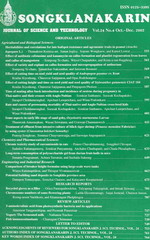ThaiScience
ThaiScience
SONGKLANAKARIN JOURNAL OF SCIENCE & TECHNOLOGY
Volume 42, No. 06, Month NOVEMBER, Year 2020, Pages 1187 - 1196
Comparative proteomic analysis reveals changes in proteome of natural rubber latex in response to hormonal stimulation and plant maturation
Waeowalee Choksawangkarn , Pairin Daengnoi , Rinya Chumkamol , Suthathip Kittisenachai , Janthima Jaresitthikunchai and Sittiruk Roytrakul
Abstract Download PDF
Availability of cis-1,4-polyisoprene from Hevea brasiliensis has become important for many kinds of products, as it is used in automobiles, gloves, and adhesives. Increasing the yield of latex from rubber trees would contribute to income in tropical countries. The latex yield depends on various factors, including plant hormones and aging. This work focused on studying the effects of these factors on dry rubber content and on proteome profiles. The results suggest that dry rubber content slightly decreased upon hormonal treatment, and increased with maturation. Both factors affected the protein concentration. Comparative proteomic analysis indicated that ethylene stimulation altered abundances of 1,553 soluble proteins and 1,001 rubber-bound proteins. Plant maturation affected abundances of 2,961 soluble proteins and 839 rubber-bound proteins. These results provide useful information about the protein-level mechanisms of rubber biosynthesis, affecting rubber yield in response to hormone treatment and aging.
Keywords
rubber latex, Hevea brasiliensis, proteomics, ethylene, agingSONGKLANAKARIN JOURNAL OF SCIENCE & TECHNOLOGY
Published by : Prince of Songkla University
Contributions welcome at : http://rdo.psu.ac.th
